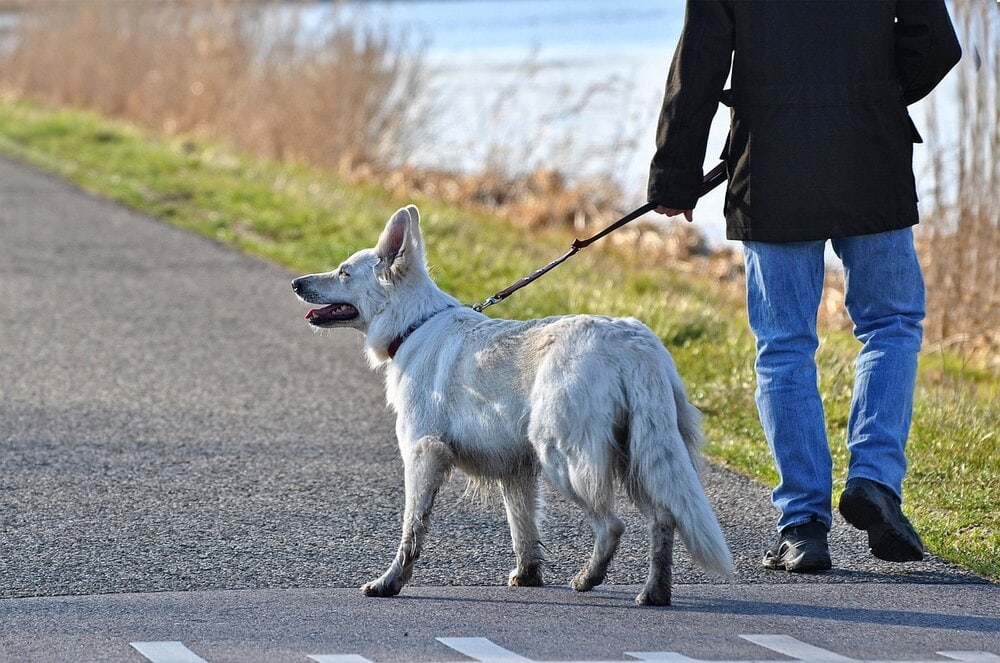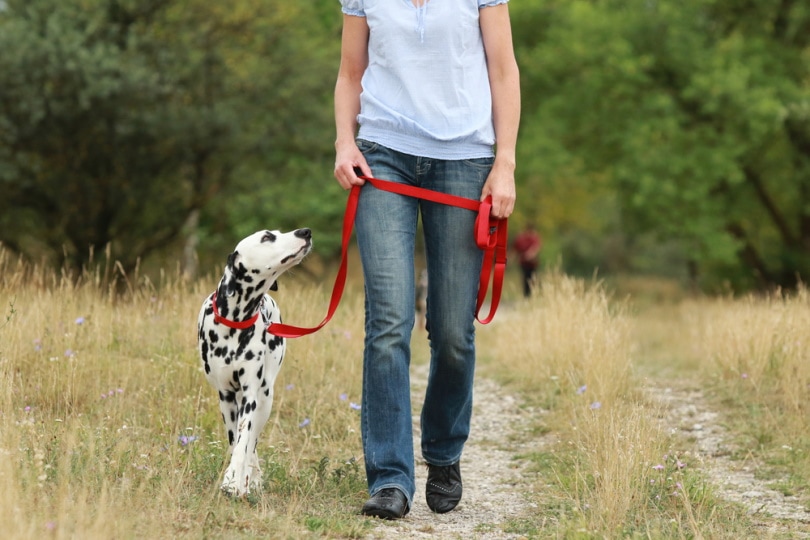Click to Skip Ahead
Note: This article’s statistics come from third-party sources and do not represent the opinions of this website.
Dogs require certain basics to be happy and healthy: good food, clean water, toys, love, companionship, and walks. Walks are more than canine bathroom breaks, as outdoor strolls allow dogs to use their amazing senses to learn more about the world around them.
Walks keep dogs healthy and mentally engaged. Millions of people get the health and social benefits that come with dog walking, but how many dogs are there in Australia? And are Australia’s dogs being walked every day? Read on for surprising dog-walking statistics from Australia.
The 10 Australia Dog Walking Statistics
- There were 28.7 million pets in Australia in 2022.
- Approximately 48% of Australian households have a dog.
- Australians spent around $33 billion on pets in 2022; 89% was on cats and dogs.
- Individuals over 65 make up approximately 11.1% of the Australian pet-owning population.
- Around 60% of dog owners regularly walk their pets.
- In 1 week, the average dog takes nine walks lasting approximately 34 minutes each session.
- Close to 57% of owners who regularly walk their dogs occasionally skip sessions.
- Approximately 78% of owners think their dog should get two walks per day.
- Pet owners will most likely spend $358.62 billion by 2027 on pet care.
- The pet tech market is forecast to reach more than $20 billion by 2028.

General Statistics About Pet Ownership in Australia
1. There were 28.7 million pets in Australia in 2022
(Animal Medicines Australia)
The number of pets in Australia increased substantially during the pandemic. Around 69% of Australian households had a dog, cat, or some other companion animal in 2022, a substantial increase from before the pandemic. In 2019, only around 61% of Australian households had pets!

2. Approximately 48% of Australian households have a dog
(Animal Medicines Australia)
Dogs were the most popular pets in Australia in 2022. Dog ownership soared during the pandemic. The percentage of Australian dog-owning households increased from 40% in 2019 to 48% in 2022. There were more than 6,375.6 million dogs owned by 4,831.1 million households in Australia in 2022. Almost 37% of all Australian dogs joined their families during or after the pandemic.
3. Australians spent $33 billion on pets in 2022; 89% was on cats and dogs
(Animal Medicines Australia)
Australians spend an astonishing amount of money on their pets, with the vast majority of those expenditures going toward food and veterinary bills. Many current pet owners would love to have another companion, but many don’t make the leap due to concerns about the cost of pet ownership.

4. Individuals over 65 make up approximately 11.1% of the Australian pet-owning population
(Pursuit)
Seniors tend to have relatively low levels of pet ownership. People under 25 and those between 45 and 54 are the most likely to have a pet. Cats are popular with those over 65 due to lower feline maintenance demands. Pet ownership often goes with parenthood; around 46% of dog-owning households also include children.
 Dog Walking Statistics
Dog Walking Statistics
5. Around 60% of dog owners regularly walk their pets
(Human Kinetics Journal)
Studies conducted in Australia and the United States looked at how often owners walk their dogs and found that some pet owners don’t regularly enjoy the great outdoors with their pets. Larger dogs tend to be walked more frequently than smaller ones. And people who are strongly attached to their dogs generally spend more time walking with them.

6. In 1 week, the average dog takes nine walks lasting approximately 34 minutes each session
(Psychology Today)
Dog ownership has amazing human health benefits, including lower stress and better cardiovascular fitness, which makes sense as the average dog-human walking pair covers around 2 miles per week. Dog ownership may motivate people to exercise more. Not only do dogs need to be walked, but many owners also find walking with their dogs improves the human-canine bond.
7. Close to 57% of owners who regularly walk their dogs occasionally skip sessions
(Psychology Today)
Even the most conscientious pet owners sometimes can’t walk their dogs. The most common reasons for skipping a walk include work responsibilities, family demands, and bad weather. Pet owners appear most likely to miss walks on Mondays. People with young children at home often end up skipping regular walks. And senior and overweight pets are often given fewer opportunities to go for strolls.

8. Approximately 78% of owners think their dog should get two walks per day
(Psychology Today)
Not all dogs require two walks a day to be healthy! While dogs need exercise, it’s fine to engage in flyball or agility training instead of relying on walking to get your pet moving. However, out-of-shape or overweight pets often benefit from a solid fitness foundation built on good old walking, which provides cardiovascular benefits without putting too much stress on canine joints.
 Pet Care and Pet Tech Statistics
Pet Care and Pet Tech Statistics
9. Pet owners will most likely spend $358.62 billion on pet care by 2027
(Fior Markets)
The international pet care market keeps expanding, primarily due to increased demand for high-quality pet food. Rising pet ownership worldwide is also a contributing factor. Pet owners are also spending more on health care and pet insurance, reflecting the increased emphasis many pet owners are putting on canine health.

10. The pet tech market is forecast to reach more than $20 billion by 2028
(Global Market Insights)
The pet tech market reached more than $5 billion in 2021, and the sector appears to be on a serious roll, as 20% growth is predicted between 2022 and 2028. Pet parents are increasingly purchasing smart products such as feeders, fountains, and toys to manage their pet’s care. Other popular options include tracking devices such as GPS collars, which allow pet parents to keep track of dogs during off-leash romps.
Frequently Asked Questions About Australia Dog Walking
Are There Other Canine Exercise Options?
Dogs require exercise to be healthy, but several fun ways to get your dog’s heart pumping don’t involve going on walks. Many dogs enjoy agility and obedience training, which involve plenty of physical activity. Some dog parks have agility equipment you can use, making it easy to try the sport to see if your pet is interested. Other activities many dogs enjoy include swimming, running, flyball, frisbee, and hiking.

What About Senior Dogs?
Walking is a great way to keep senior dogs fit. Exercise helps dogs maintain a healthy weight and can increase mobility and reduce pain in some pets suffering from degenerative joint disease. While dogs with osteoarthritis often benefit from movement, it’s important not to encourage them to engage in activities like jumping and running that could stress their joints. Swimming and gentle walking are perfect! (The Conversation)
How Do I Find a Dog Walker?
Many pet parents find dog walking help through informal channels. Consider asking fellow dog-owning neighbors for recommendations. Alternatively, several apps and websites connect dog walkers and clients. Interview a few prospective walkers and ask questions about their experience working with pets similar to yours. And be sure to clearly communicate what you’re looking for; if your dog prefers slow, solo sniff walks and despises cats, let the dog walker know!

How Much Exercise Do Dogs Need?
Dogs need anywhere from 30 minutes to more than 2 hours of daily exercise depending on factors such as age, breed, and health conditions. Small breeds like chihuahuas often only require around 30 minutes per day, and active species like Huskies often benefit from multiple hours of physical activity. Older pets and puppies can sometimes only tolerate gentle exercise in shorter sessions. (PetMD)
What’s a Sniff Walk?
A scent walk is simply an outdoor stroll in which you permit your pet to take things at their own pace, allowing them to stop and sniff at leisure. It’s a different activity from an exercise walk or a quick bathroom break, as you’re letting your dog set the pace and determine where to go.
You can teach your dog the difference between scent and regular walks, so they’ll know when to stop and sniff at their leisure. Some evidence suggests that regular sniff walks may even improve some types of bad doggy behavior. (PetMd)

How Much Do Dog Walkers Earn?
Professional dog walkers in Australia often earn around AU $24 per hour. However, that can vary from as low as AU $17 to as high as AU $30 per hour. Those with 1–4 years of experience only earn a few dollars per hour more than individuals just starting out in the business.
It’s often a part-time job, and many dog walkers work as independent contractors. Some provide additional services such as pet sitting for clients who need someone to look after their dog for a few days. Many take classes and obtain certifications in canine obedience, behavior, and first aid. (Payscale)
Do Humans Benefit from Walking Their Dogs?
Evidence suggests that pet ownership and being around animals can lower human stress and anxiety. And those health benefits multiply when dog owners engage in physical activities with their pets. Regular walking has many human health benefits, including improved heart health, stronger bones, and more conditioned muscles.
Having a dog often motivates people to get up and move, making it easier to reach the 150 minutes of weekly physical exercise recommended by the World Health Organization. (Harvard Health Publishing, Mayo Clinic, World Health Organization)
Conclusion
Australians owned more than 28.7 million pets in 2022, including dogs, cats, fish, and reptiles. But dogs were by far the most popular companion animals in 2022, with more than 48% of Australian households owning at least one dog! The continent was home to more than 6,375.6 million pet dogs living in 4,831.1 million households. Most of those dog owners regularly walked their dogs, although some missed a few days here and there. Walks help dogs stay engaged, content, and happy.
Featured Image Credit: New Africa, Shutterstock




 Pet Care and Pet Tech Statistics
Pet Care and Pet Tech Statistics






